
Agata Kus, Vorsicht Bissige Hündin - Beware of the Bad Bitch
16.11.2013 until 08.01.2014
Agata Kus, an artist gifted with a special sensibility, engages the audience in a game of opposites. She can create indisputably beautiful, technically seductive things, painting lustrous dog hair, haptic furs and attractive, pensive faces. On the other hand, she often ‘destroys’ the painting, paints over it, burns holes in it or even apparently throws away hours of work by obscuring the main image and covering it with a slogan that looks like words sprayed on a wall.
Meticulous care is taken to render subtle details: beautiful lace, veils, flowers. But she can also leave certain details unfinished, abandon them halfway through. She can be girlish and delicate, only to ridicule, expose, turn it into a joke and hit hard a moment later. Her figures are fragile, delicate, terrified, brooding and frozen in ‘that’ crucial moment, but they are also shocking and terrifying, like the women wearing furs-scalps or those kissing corpses.
Now for a seemingly obvious observation: Kus paints people, a choice consistent with the current triumphant return to this classic type of figurativeness. Novelty of form is achieved by different means today, experiments take place on other levels. Her topics are human stories, whether complex or snapshot-like. This complete artistic universe is created by painterly means of the highest order, because Kus is a painter par excellence.
A fragment from the text to the catalog Agata Kus. Paintings. Publishing House Talking Dog, Cracow, 2016.Agnieszka Gołębiewska, Göttingen (Germany)
Caution biting bitch!
The images of women have been present in art since the prehistoric times. Believing in their magic power, the primeval man created tiny figurines of goddesses with exaggerated fertility attributes. The ancient Greeks idealised women’s figures, creating the unattainable ideal of beauty which had been continously rediscovered and reinterpreted until the 20th century. Yet, a crucial moment in perceiving women and their sexuality turned out to be the relatively short period of the Middle Ages. The active thinkers and philosophers of the period, such as Saint Augustine or Saint Thomas Aquinas, propagated the views of inferiority of representatives of the female gender and their biological handicap. It was then that the woman’s body was covered up with the stiff folds of clothes in order to hide its sinful and treacherous nature. In fine arts, the Renaissance rediscovered the beauty of woman’s body and the pleasure derived from watching it. However, the approach towards the worse position of the female gender had prevailed till the 20th century. In the period of the 70s of the last century feministic art gained its recognition and women-artists could speak for themselves without inhibitions for the first time in history. They began to discover their sexuality and repressed emotions.
The successor of these ideas is a young Polish artist Agata Kus, whose exhibition entitled ”Beware of the Bad Bitch” is just being shown in Galerie Sandhofer. It is not though a passive reproduction of the subject matters of the 70s. Kus has developed an individual and complex visual language, operating with symbols and metaphors. By its means, the artist analyses the mutilation of contemporary girls and women. The mother-daughter conflict, Freudian complex of the lack of penis, the denial of one’s own sexuality, promiscuity, unwillingness to have children constitute only a small part of the difficult emotionsnKus focuses on. She describes them in the text of her diploma dissertation entitled “Lady Bitch- Transgressions of Femininity” as the confession of a mysterious Kitty who is a fusion of numerous individual problems and stories. The painful emotions joined in Kitty manifest forcefully in the dichotomy between the ideal image of contemporary women and their well-hidden inner world. The world they only dare to talk about during a psychotherapy.
Fascinated by the psychodynamic concepts of such psychologists as, for example, Melanie Klein, Hanna Segal and Karen Horney, the artist also takes her inspirations out of fairy tales. Their symbolic language as though reflected best the complexity of the feelings connected with maturity and the difficult transformation from an innocent child into a liberated and self-sufficient woman. Hence, along with little girls, many of Kus’s paintings depict does, dogs, foxes and she-wolves. In one of the painting of the ”Solution II” cycle (2010), little girls crouched by a doe. The animal lies on the back with its legs pulled up. There is a wound on its belly with many jewels inside. The girls are looking with keen interest at the colourful trinkets. One of them, obviously fascinated with the sight of the precious stones, reaches for a single one. The work symbolizes offering the gift of life, which constitutes the essence of femininity in biological terms. The doe sacrifices its life to the girls so that in the future they would be able to break up with the carefree life and give it away to their offspring.
A dog make a similarly positive symbol. It dies too, offering the jewels of fidelity, attachment and love to its offspring, as so it does the big, black mastiff bitch. However, the dog diving in water in the ”Aus dem Blauen” cycle(2009), refers to the search of one’s identity, the ”I” deeply hidden in the subconscious.We hereby reach the ambiguous depiction of the she- wolf. The artist frequently returns to the image of the famous, Etruscan sculpture of the 5th century B.C. The Capitoline she-wolf, feeding the human babies- Remulus and Remus - is the embodiment of gentleness and maternal feelings. On the other hand, she seems scary, demonic and wild. This seems to be a parallel of a dysfunctional relationship of the mother and child.
The she-wolf of Agata Kus’s paintings appears to be the life giver and the one which can take life away in any moment. A vixen which tempts a little, red-haired girl is an equally disturbing and recurring motif. It presents the girl with a ruby which is meant to encourage her to accept the gift of maturity. The sensual and cunning vixen will lead the child to adulthood giving her a red spot in return- on the underwear at first, then on a bed sheet. As the act of revenge, the girl will put on a fox fur when she grows up. Like in the paintings of ”The Hidden’’ cycle (2008/2009), she will shelter under its sensual, soft material and become ”the bitch’’. The artist provocatively uses colloquialisms fulfilling the pained scenes. The women in her paintings are ”the bitches’’. There is no mercy for them. ’’They are not fit to be mothers’’ so they deserve contempt. They are liberated so they get wasted:” Bitches”! The artist quotes the buzzwords we hear every day in the streets, on a bus, in a café. This insolent, misogynist manner reminds ”Cinnamon Shops “ by Bruno Schulz for whom women constituted just the tempting ”meat”. Agata Kus’s art is exceptionally mature and thoroughly moving. It makes us realise how the embedded cultural and social codes result in the inner conflict of girls and women. Despite emancipation and equality, women keep balancing on the thin line between the things considered proper and the ones which turn them into ”bitches’’’. The patriarchal society places mutually exclusive demands which consequently make women discover their femininity in a long and arduous manner.
Paulina Sadowska
-
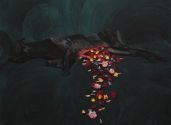
"Wound" 2012 (SOLD)
-
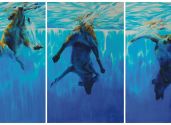
"Into The Deep" 2009 Triptych
-

"Diving" 2009
-

Untitled 2010
-

"Kurtain" 2012
-
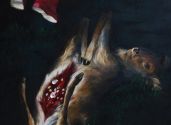
"Delivery III" 2010
-
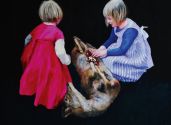
"Delivery II" 2010
Photo Documentation of the Exhibition
-
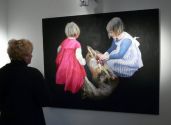
P1120486
-
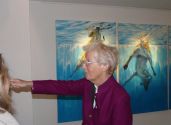
P1120503
-
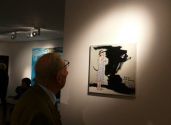
P1120492
-
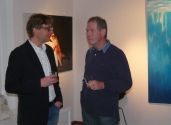
P1120513
-

P1120500
-
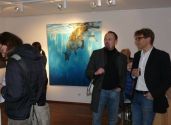
P1120507
-

P1120517
-

P1120505
-
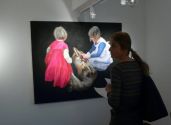
P1120501
-

P1120521
-

P1120525
-
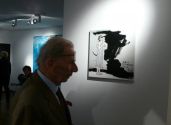
P1120493
-
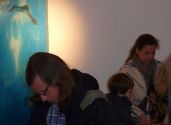
P1120515